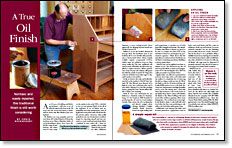A True Oil Finish
Nontoxic and easily repaired, this traditional finish is still worth considering
Synopsis: Chris Becksvoort has used all the oil finishes available today and finds Tried and True, available since the early 1990s, to be the best. It also has the added benefit of being nontoxic with all the attributes of an oil finish: spot repairability, easy application and maintenance, quick build of finish, and fine patina.
After 30 years of building and finishing furniture, I still turn to an oil finish for almost all of my work. Oil seeps into the wood and leaves a handrubbed sheen that film finishes just can’t replicate.
Oil finishes are very popular, and I’ve tried them all: boiled linseed oil from the hardware store, Watco, Waterlox, Velvit, oil and polyurethane mixes, Livos (now Bio Shield), tung oil and Minwax. But when Tried & True came on the market in the early 1990s, I decided to use it as my primary finish. It has all of the attributes of an oil finish: spot repairability and easy maintenance, ease of application and quick build of both the finish and the patina. However, what really sealed it for me was the fact that I would no longer be exposing myself and my customers to toxic metal and petroleum driers contained in most other oils. I have no qualms about using Tried & True for baby cribs, children’s furniture or even cutting boards. Never again will I be dipping my bare hands into “boiled” linseed oil.
Believe it or not, the “boiled “ linseed oil you get from the hardware store is not boiled at all. It’s raw oil with either petroleum or heavy-metal driers. Many contain volatile organic compounds (VOCs), which cause air pollution. Even so, they never really dry. The raw, unfiltered oils used in most oil finishes should not be applied to cabinet interiors. When opened, one of my 30-year-old cabinets still greets me with the smell of rancid oil. Tung oil is a decent oil finish, but it takes ages to dry, and it tends to turn yellow.
As far as I know, the only real boiled linseed oil on the market is Tried & True Varnish Oil. This filtered, pure linseed oil is light in color, has a pleasant odor and is very thick. Wiping it is a bit like pushing honey, giving the term “hand-rubbed finish” a whole new meaning.
Tried & True was developed by Joe Robeson, a furniture maker in Trumansburg, N.Y. He found an 1850 formula for producing the oil used in coach-makers varnish. Heat causes the oil to polymerize and absorb oxygen when drying, yielding a bright, durable finish. Robeson found the right boiling time and temperature to produce an oil with great film strength and beauty. The Material Safety Data Sheet is almost too good to be true. It contains less than 0.1% of any substances listed as carcinogens by government agencies. Think about that the next time you stick your bare hands into an oil finish containing petroleum distillates or heavy-metal driers.
Tried & True can be applied over bare or stained wood. The directions say the oil and wood should be at least room temperature (70°F). But heating the oil to 120°F in a glue pot makes it penetrate better.
From Fine Woodworking #152
For the full article, download the PDF below:
Fine Woodworking Recommended Products

Dividers


Olfa Knife






















Log in or create an account to post a comment.
Sign up Log in